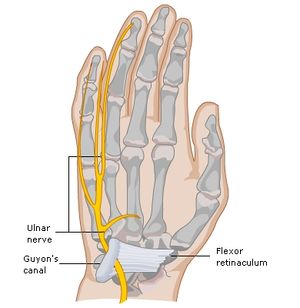Guyon Canal: Difference between revisions
(Created page with "{{subst:Bones}}") |
No edit summary |
||
| Line 1: | Line 1: | ||
<div class="editorbox"> | <div class="editorbox"> | ||
'''Original Editor''' - [[User: | '''Original Editor''' - [[User:Lilian Ashraf|User Name]] | ||
'''Top Contributors''' - {{Special:Contributors/{{FULLPAGENAME}}}} | '''Top Contributors''' - {{Special:Contributors/{{FULLPAGENAME}}}} | ||
</div> | </div> | ||
[[File:Ulnar nerve.jpg|thumb|Guyon Canal]] | |||
== Description == | == Description == | ||
Guyon’s canal also called ulnar tunnel or ulnar canal, is an anatomical fibro-osseous canal located on the medial side of the hand. It extends between the proximal boarder of the [[pisiform]] bone and distally at the hook of the [[hamate]]. The [[Ulnar Nerve|ulnar nerve]] and ulnar artery pass through the Guyon canal as they pass from distal forearm to the hand.<ref name=":0">Ramage JL, Varacallo M. Anatomy, Shoulder and Upper Limb, Hand Guyon Canal.</ref><ref>Depukat P, Mizia E, Kłosiński M, Dzikowska M, Klimek-Piotrowska W, Mazur M, Kuniewicz M, Bonczar T. Anatomy of Guyon's canal-a systematic review. Folia Medica Cracoviensia. 2014;54(2).</ref> | |||
== | == Contents == | ||
The Guyon canal houses the ulnar nerve and its branches, ulnar artery and venous and lymphatic vessels. As the ulnar nerve exits the Guyon’s canal it is divided into deep (motor) branch of the ulnar nerve and superficial (sensory) branch of the ulnar nerve.<ref name=":0" /><ref>Vargas A, Chiapas-Gasca K, Hernández-Díaz C, Canoso JJ, Saavedra MÁ, Navarro-Zarza JE, Villaseñor-Ovies P, Kalish RA. Clinical anatomy of the hand. Reumatologia clinica. 2012 Dec 1;8:25-32.</ref> | |||
== | == Boarders == | ||
* Roof: palmar carpal ligament, [[Palmaris Brevis|palmaris brevis]] and hypothenar connective tissue. | |||
* Floor: transverse carpal ligament, pisohamete ligament, pismetacarpal ligament, [[Flexor digitorum longus|flexor digitorum profundus]] tendons and [[Opponens Digiti Minimi|opponens digiti minimi]]. | |||
* Medial wall: [[pisiform]], [[Abductor Digiti Minimi (Hand)|abductor digiti minimi]] and [[Flexor Carpi Ulnaris Muscle|flexor carpi ulnaris]] tendon. | |||
* Lateral wall: hook of [[Hamate|hamete]], transverse carpal ligament and the flexor tendons.<ref>Hoogvliet P, Coert JH, Fridén J, Huisstede BM. How to treat Guyon's canal syndrome? Results from the European HANDGUIDE study: a multidisciplinary treatment guideline. British journal of sports medicine. 2013 Nov 1;47(17):1063-70.</ref> | |||
== | == Clinical Relevance == | ||
[[Guyon Canal Syndrome|Guyon canal syndrome]] is the second reason for compression syndromes at the wrist after [[Carpal Tunnel Syndrome|carpal tunnel syndrome]]. Compression of the ulnar nerve at the Guyon’s canal leads to specific sensory and motor symptoms according to the location of the compression.<ref name=":0" /> | |||
Hypothenar hand syndrome is caused by repeated trauma to the hypothenar region, resulting in injury to the ulnar artery in Guyon space.<ref>Yuen JC, Wright E, Johnson LA, Culp WC. Hypothenar hammer syndrome: an update with algorithms for diagnosis and treatment. Annals of plastic surgery. 2011 Oct 1;67(4):429-38.</ref> | |||
= References = | == References == | ||
<references /> | <references /> | ||
[[Category:Anatomy]] [[Category:Bones]] | [[Category:Anatomy]] | ||
[[Category:Bones]] | |||
[[Category:Hand - Anatomy]] | |||
[[Category:Wrist - Anatomy]] | |||
Revision as of 20:54, 11 December 2020
Original Editor - User Name
Top Contributors - Lilian Ashraf, Kim Jackson and Daphne Xuan
Description[edit | edit source]
Guyon’s canal also called ulnar tunnel or ulnar canal, is an anatomical fibro-osseous canal located on the medial side of the hand. It extends between the proximal boarder of the pisiform bone and distally at the hook of the hamate. The ulnar nerve and ulnar artery pass through the Guyon canal as they pass from distal forearm to the hand.[1][2]
Contents[edit | edit source]
The Guyon canal houses the ulnar nerve and its branches, ulnar artery and venous and lymphatic vessels. As the ulnar nerve exits the Guyon’s canal it is divided into deep (motor) branch of the ulnar nerve and superficial (sensory) branch of the ulnar nerve.[1][3]
Boarders [edit | edit source]
- Roof: palmar carpal ligament, palmaris brevis and hypothenar connective tissue.
- Floor: transverse carpal ligament, pisohamete ligament, pismetacarpal ligament, flexor digitorum profundus tendons and opponens digiti minimi.
- Medial wall: pisiform, abductor digiti minimi and flexor carpi ulnaris tendon.
- Lateral wall: hook of hamete, transverse carpal ligament and the flexor tendons.[4]
Clinical Relevance[edit | edit source]
Guyon canal syndrome is the second reason for compression syndromes at the wrist after carpal tunnel syndrome. Compression of the ulnar nerve at the Guyon’s canal leads to specific sensory and motor symptoms according to the location of the compression.[1]
Hypothenar hand syndrome is caused by repeated trauma to the hypothenar region, resulting in injury to the ulnar artery in Guyon space.[5]
References[edit | edit source]
- ↑ 1.0 1.1 1.2 Ramage JL, Varacallo M. Anatomy, Shoulder and Upper Limb, Hand Guyon Canal.
- ↑ Depukat P, Mizia E, Kłosiński M, Dzikowska M, Klimek-Piotrowska W, Mazur M, Kuniewicz M, Bonczar T. Anatomy of Guyon's canal-a systematic review. Folia Medica Cracoviensia. 2014;54(2).
- ↑ Vargas A, Chiapas-Gasca K, Hernández-Díaz C, Canoso JJ, Saavedra MÁ, Navarro-Zarza JE, Villaseñor-Ovies P, Kalish RA. Clinical anatomy of the hand. Reumatologia clinica. 2012 Dec 1;8:25-32.
- ↑ Hoogvliet P, Coert JH, Fridén J, Huisstede BM. How to treat Guyon's canal syndrome? Results from the European HANDGUIDE study: a multidisciplinary treatment guideline. British journal of sports medicine. 2013 Nov 1;47(17):1063-70.
- ↑ Yuen JC, Wright E, Johnson LA, Culp WC. Hypothenar hammer syndrome: an update with algorithms for diagnosis and treatment. Annals of plastic surgery. 2011 Oct 1;67(4):429-38.







